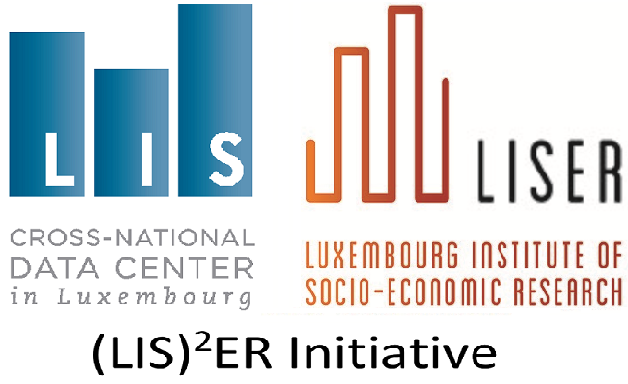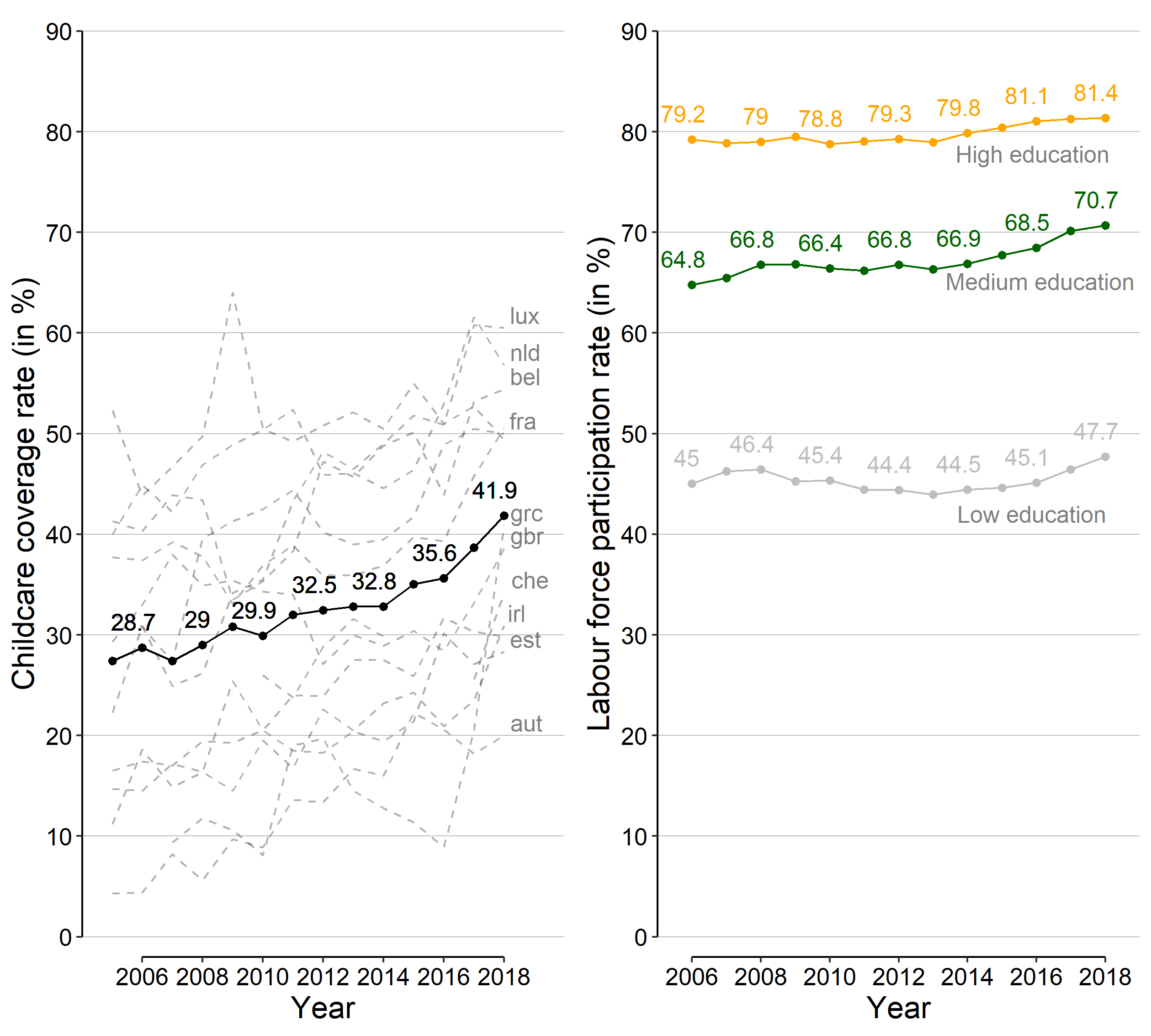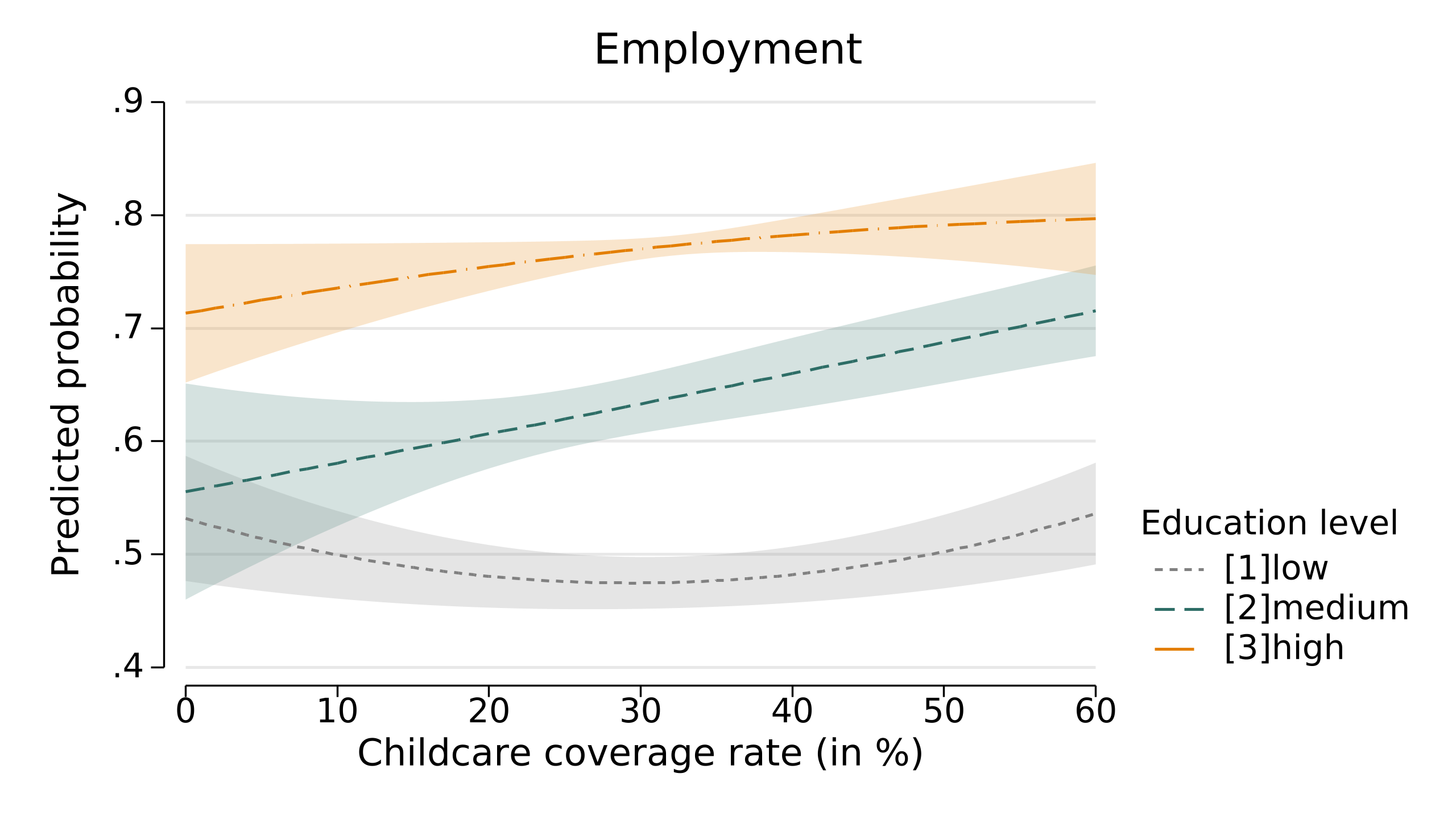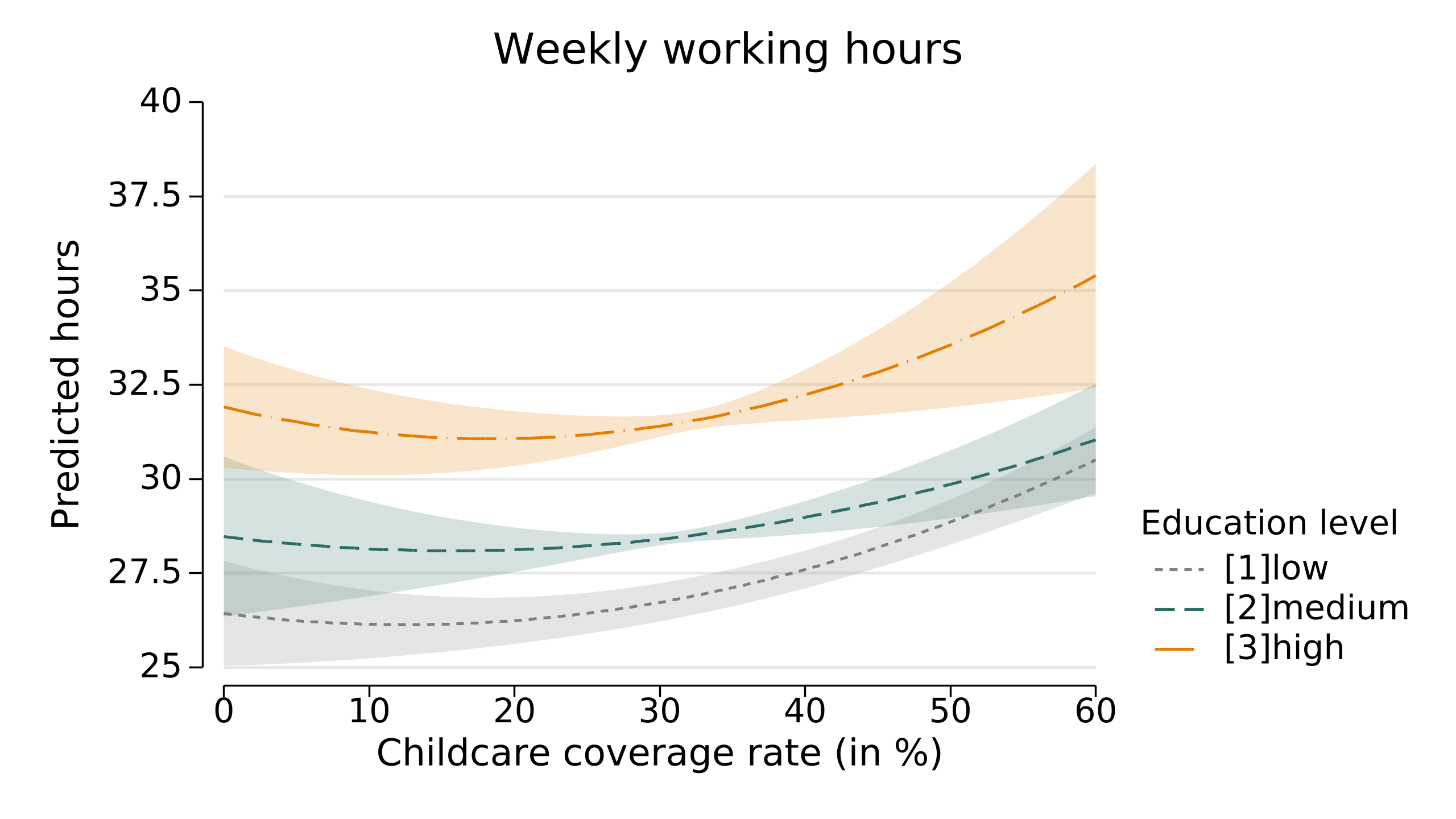
Issue, No.29 (March 2024)
Uneven Effects of Childcare Expansion?*
Introduction
In recent decades, welfare states have experienced a renewed interest in family policies, particularly since the beginning of the 21st century, marked by a paradigm shift towards family-work reconciliation policies. A key policy has been the expansion of childcare for children under the age of three years (Ferragina, 2019). Publicly organised childcare allows families to transfer childcare responsibilities from the private to the public sphere. The use of public childcare can reduce work interruptions in mothers’ careers, facilitate their (re-)entry into the labour market and aim to reduce inequality between genders. However, the outcomes of work-family reconciliation policies have been uneven, giving rise to what scholars have termed “welfare state paradoxes” (Mandel and Semyonov, 2005; Mandel and Semyonov, 2006; Korpi et al., 2013) and “gendered trade-offs” (Pettit and Hook, 2009). Both hypotheses discuss how reconciliation policies can have unintended, paradox, or adverse consequences for women and mothers. While childcare services may facilitate women’s (re-)entry into the labour market, the jobs available may entail precarious working conditions and labour market segregation, and the associated risks may not be evenly distributed among women. Lower class women often face the double pressure of poor working conditions and the need to augment household income. In contrast, higher-class women often perceive their (re-)entry into the labour market as tied to career opportunities rather than economic necessity. This raises the question of whether the expansion of childcare is leading to greater inequality within gender according to social class.
The analysis examines whether increased childcare coverage leads to higher labour market participation of mothers. Therefore, I analyse two labour market outcomes to answer the questions: 1) Do mothers from different social classes react differently to childcare expansion regarding labour market inclusion? and 2) Does childcare expansion affect their working hours differently?
The effects of childcare expansion on mothers’ labour market participation remain unclear, with scholars suggesting different mechanisms and finding different results for women in different social classes.1 Some studies show minimal effects of childcare expansion on labour market outcomes, attributing this to the so-called Matthew effect, where highly educated women have the financial means to outsource childcare regardless of the availability of public childcare services. When public childcare expands, they switch from expensive private arrangements to affordable public childcare, so that the participation rates of highly educated mothers are high regardless of childcare policies (Pavolini and Van Lancker, 2018). Other findings show that low-educated mothers are the most responsive to an increase in public childcare, as they have higher financial pressure to (re-)enter the labour market to increase their household income, and public childcare reduces private responsibilities (Scherer and Pavolini, 2023). However, in addition to different methodological decisions, different results also emerge from using different time periods in the analysis, treating family policies separately or as policy packages, including contextual factors such as earning inequality in a country (Hook and Paek, 2020), or grouping countries based on typologies (Korpi et al., 2013).
For my analysis, I used data from 13 countries and 118 country years from the Luxembourg Income Study (LIS). I utilised a pooled dataset with data from 2005 and 20182 and combined it with data from Eurostat on childcare coverage rates for children under three years, in order to contribute to the debate on paradoxes and trade-offs. Thereby, I operationalised class by education level and focused on married women between 25 and 45 years old with children between 1 and 6 years. I ended up with 120,734 cases for the first and 70,101 cases for the second research question.
Changes in childcare coverage and labour market participation of mothers
Figure 1 shows the development of childcare coverage rates for children under three years of age (left) and maternal employment rates (right) between 2005 and 2018 in the 13 analysed countries. On average, childcare coverage increased by 14.5 percentage points over this period. Although there are significant differences in childcare coverage rates between countries, the common pattern shows an increase for almost all countries. The right panel suggests a high disparity in labour force participation by education level. In 2006, around 45 per cent of mothers with low educational attainment were employed. By 2018, there was a minor increase of 2.2 percentage points. Highly educated women exhibit high levels of labour force participation. In 2006, almost 80 per cent were employed, and by 2018, there was a minor increase of 2.2 percentage points. Medium-educated mothers fall in between. At the beginning of the observation period in 2006, 64.8 per cent of them were employed. This group increased the most by 5.9 percentage points to 70.7 per cent.

Figure 1: Left panel: Childcare coverage rate for children under the age of 3 years. Eurostat data between 2005 and 2018 for 13 countries (dashed lines). Yearly mean of childcare coverage for children under the age of 3 years. Indicator: tepsr_sp210 (Eurostat, 2023). Right panel: Labour force participation of mothers by education level and with at least one child under 14 years, yearly mean for the 13 used countries. OECD family database. LMF1.2 (OECD, 2023). Own calculations.
Looking at macro-level trends, an increase in childcare coverage for very young children correlates with higher labour force participation among mothers. This trend suggests that it is predominantly middle-class mothers who have simultaneously entered the labour market in response to the expansion of childcare.
Heterogeneous effects on employment?
To examine these macro-level developments more closely, the following section presents the predictions of the interaction of macro-level childcare coverage rates and micro-level educational attainment of the mothers for two different labour market outcomes calculated in regression models.3 The results suggest that there are level differences in the labour market participation of mothers depending on their educational level (see Figure 2). As childcare coverage increases, the difference between low and medium-educated mothers also increases and becomes significantly different. The slight increase for highly educated mothers can be explained by a ceiling effect, as there is already a high level of employment (0.71) at low coverage rates, which strengthens the hypothesis of the Matthew effect. For low-educated mothers, the effect on participation seems to be minimal. Additionally, a U-shaped relationship is evident, with both low and high childcare coverage rates corresponding to higher employment probabilities. Medium-educated mothers show a high responsiveness to changes in childcare coverage rates. There is a clear positive effect of higher childcare coverage rates on mothers’ employment, with the probability increasing from 0.55 to 0.72 on average.

Figure 2. Predicted probability of employment by three education levels. Luxembourg Income Study (LIS). Own calculations.
When comparing the level of working hours (see Figure 3), differences between the levels of education are also apparent. Highly educated women work the most, and without childcare, their weekly working hours are, on average, around 32 hours, increasing to just over 35 hours. Mothers with a medium level of education increase their working time by approximately 3 hours (from 28 to 31 hours) as the childcare coverage rate increases from 0 up to 60 per cent.
While mothers with lower education work on average slightly more than 26 hours per week without childcare coverage, they have a more pronounced increase in working hours starting from a coverage rate of 30 per cent. When childcare coverage reaches 60 per cent, the average working hours are almost the same level as for mothers with a medium level of education, at 30 per cent.

Figure 3. Predicted weekly working hours by three education levels. Luxembourg Income Study (LIS). Own calculations.
Discussion
I find differences in labour market outcomes for mothers in different classes, regardless of the childcare coverage. Contrary to previous research, I find a positive effect of higher childcare coverage rates on labour market inclusion for middle-class mothers. On the one hand, this can be explained by a possible Matthew effect: Mothers from higher social class (re-)enter the labour market anyway and are less dependent on childcare facilities because they can afford to organise childcare privately. Even if they profit from public childcare facilities, this is not reflected in higher employment rates. On the other hand, lower-class mothers do not respond to the expansion of childcare facilities, which may contradict the hypothesis of the need for a second family income. For middle-class mothers in particular, childcare expansion seems to be a possibility for them to (re-)enter the labour market, and the policy arrangement may have a greater impact on their decision. However, for those who do enter the labour market, high childcare coverage may have a stronger effect on working hours for lower class mothers. For those mothers who work, a high childcare coverage enables them to work more hours per week.
In the context of the paradox and trade-off hypothesis, it is necessary for further research to investigate other dependent variables that measure labour market segregation and income distribution (which I examine in a forthcoming paper) in order to also cover the working conditions. The responsiveness of middle-class mothers may also be related to the sectors and jobs where flexible working arrangements are more common, making it possible to combine care and work. On top of that, the cost of childcare facilities may influence the threshold at which earnings compensate for childcare costs, which may be an essential consideration, especially for mothers from lower social classes.
* This article is an outcome of a research visit carried out in the context of the (LIS)2ER initiative which received funding from the Luxembourg Ministry of Higher Education and Research.
1 Class is often operationalized by education level.
2 Due to missing data for specific variables, I used an unbalanced dataset of the following countries: Austria, Belgium, Estonia, France, Germany, Greece, Ireland, Luxembourg, Netherlands, Spain, Sweden, Switzerland, and the UK.
3 A forthcoming paper provides concrete model specifications. Pooled weighted regression models with controls for individual characteristics, macro characteristics, year, country, and country*education level fixed effects are used. Furthermore, robust and clustered country-specific standard errors are used.
References
| Eurostat (2023) ‘Children Aged Less than 3 Years in Formal Childcare’. Received from: https://ec.europa.eu/eurostat/databrowser/view/tepsr_sp210/. |
| Ferragina, E. (2019) ‘The Political Economy of Family Policy Expansion’, Review of International Political Economy, 26, 1238–1265. |
| Hook, J. L. and Paek, E. (2020) ‘National Family Policies and Mothers’ Employment: How Earnings Inequality Shapes Policy Effects across and within Countries’, American Sociological Review, 85, 381–416. |
| Korpi, W., Ferrarini, T. and Englund, S. (2013) ‘Women’s Opportunities under Different Family Policy Constellations: Gender, Class, and Inequality Tradeoffs in Western Countries Re-Examined’, Social Politics: International Studies in Gender, State & Society, 20, 1–40. |
| Luxembourg Income Study (LIS) (2023) ‘Luxembourg Income Study (LIS) Database’. |
| Mandel, H. and Semyonov, M. (2005) ‘Family Policies, Wage Structures, and Gender Gaps: Sources of Earnings Inequality in 20 Countries’, American Sociological Review, 70, 949–967. |
| Mandel, H. and Semyonov, M. (2006) ‘A Welfare State Paradox: State Interventions and Women’s Employment Opportunities in 22 Countries’, American Journal of Sociology, 111, 1910–1949. |
| OECD (2023) ‘OECD Family Database’. Received from: https://www.oecd.org/els/family/database.htm. |
| Pavolini, E. and Van Lancker, W. (2018) ‘The Matthew Effect in Childcare Use: A Matter of Policies or Preferences?’, Journal of European Public Policy,25, 878–893 |
| Pettit, B. and Hook, J. L. (2009) Gendered Tradeoffs: Family, Social Policy, and Economic Inequality in Twenty-One Countries, New York, NY, Russell Sage Foundation. |
| Scherer, S. and Pavolini, E. (2023) ‘Equalizing or Not? Public Childcare and Women’s Labour Market Participation’, Journal of European Social Policy, 33(4), 436-450. |
